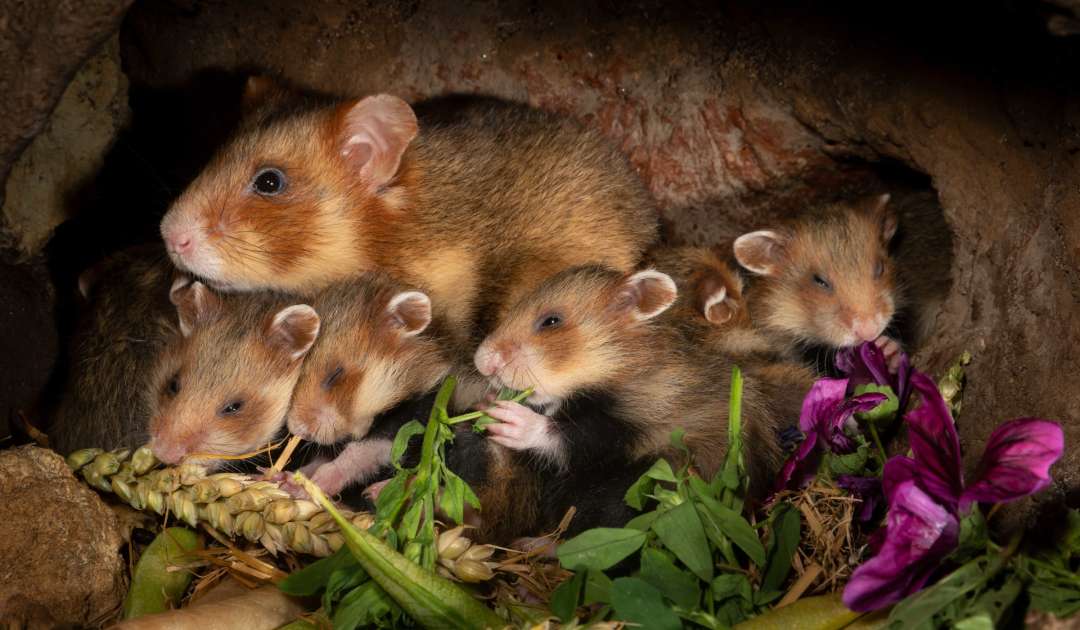Sustainable support for the Common hamster
New research project in the German state of Hesse to aid the conservation of a highly endangered species
It is one of the most endangered mammal species in Western Europe: the Common hamster (Cricetus cricetus), also known as the European hamster. Once hunted intensively as an “agricultural pest” and for its multi-coloured furs, a significant decline in its population has been recorded since the 1970s. Without further research and conservation measures, the Common hamster could become completely extinct in the next twenty years, according to forecasts. Preventing this in Hesse, Germany, is the goal of the new project “MetaHamster”, which focuses primarily on genomic data and involves scientists and conservation actors from various institutions, including the Senckenberg Society for Nature Research and the LOEWE Centre for Translational Biodiversity Genomics (LOEWE Centre TBG) in Frankfurt am Main. The project is funded by the State of Hesse within the framework of the Lore Steubing Institute (LSI) for Nature Conservation and Biodiversity of the Hessian Agency for Nature Conservation, Environment and Geology (HLNUG).
Despite previous protective measures, there are still many reasons for the ongoing decline in the population of the Common hamster. Agriculture on industrial scale with intensive soil cultivation and early harvest times are probably among them. Furthermore, habitat loss due to increasing infrastructure and urbanization in agricultural areas in recent decades prevents the migration of animals and the important exchange of genetic material: in isolated small populations, inbreeding occurs, and genetic diversity is lost. There are currently just ten genetically divergent wild populations of this short-lived rodent left in Hesse. In several other German states, the rodents have already disappeared. With them, an important supporter in turning the agricultural soils vanished: through their underground burrow construction, the animals, which can be up to 30 centimetres in size and weigh 600 grams, mix the soil, and thus contribute to the fertility of the agriculturally used land.
A multi-stage project has now started to foster to the conservation of the Common hamster in Hesse and other regions. A central element of the project “MetaHamster” is the evaluation and use of genomic data. First, historical evidence from the collections of the Senckenberg Natural History Museum in Frankfurt is reviewed and current samples from all remaining populations are compiled to provide insight into the past and current genetic composition of the species. For this purpose, Common hamster conservationists and citizen scientists collect hair and faecal samples as source for genetic analysis. The LOEWE Centre TBG will be analysing several complete Common hamster genomes, providing detailed insights into the genetic composition and the level of detrimental inbreeding within the declining populations. The data will be entered into a genetic database as future central source of information for conservation measures. Finally, a so-called metapopulation model, which gives name to the project, is created to enable forecasts regarding the future status of this declining species in Hesse, assuming various environmental scenarios and levels of human impact. For this purpose, all European breeding and reintroduction projects will be analysed and previous models of dynamics in wild populations are envisioned to be included.
“Our goal is to develop a sustainable overall concept for the conservation of the Common hamster in Hesse. In doing so, we want to build on the previous initiatives of Common hamster conservation and use new genomic data from which much can be learned about the development and inbreeding load in each population,” reports project leader Dr Tobias Erik Reiners, a scientist at the Senckenberg Research Institute and Natural History Museum Frankfurt and the LOEWE Centre TBG. “The remaining genetic diversity is of utmost importance for the long-term future of the Common hamster, i.e., the diversity and flexibility in the genome that enables the species to maintain its reproductive capacity, recolonization, and adaptability in times of global change,” he continues.
Axel Janke, Professor of Comparative Genomics at the LOEWE Centre TBG, at Senckenberg and the Goethe University emphasises: “The comprehensive sequencing of Common hamster genomes at the LOEWE Centre TBG not only promotes the understanding of genetic diversity for the conservation of species, but also provides important impulses for modern conservation management, which increasingly uses genomic data for tailor-made conservation strategies. We have already been able to demonstrate this with other species, including giraffes, for example. I am pleased about the funding of the new ‘MetaHamster’ project, also on a personal level: at one of my workplaces, the natural science campus of Goethe University in Frankfurt’s Riedberg district, the Common hamster has unfortunately disappeared with the development of the huge new housing estate.”
“What convinced us most about the project was its relevance for nature conservation practice. With the adaptable model, which can calculate developments for the next ten years with the compiled data, practical recommendations for action are possible, among others to the ‘Steering Group for Breeding and Reintroduction of the Common hamster in Hesse’, for a sustainable genetic management of this endangered species,” says Prof. Dr Thomas Schmid, President of HLNUG and Managing Director of LSI.
Another project partner is the Working Group for Common hamster Protection of the Hessian Society for Ornithology and Nature Conservation (HGON). The new project entitled “Genetic monitoring and management for a sustainable metapopulation of the Common hamster in Hesse (MetaHamster)” is made possible by a four-year grant of around 165,000 euros from the HLNUG within the LSI framework until mid-2027.
Information:
https://www.hlnug.de/themen/naturschutz/lore-steubing-institut/projekte/feldhamster




